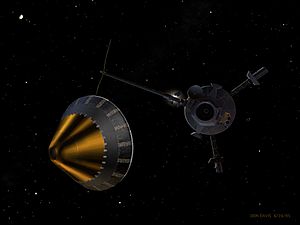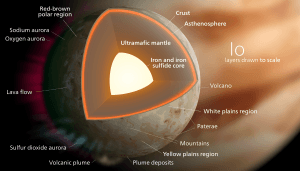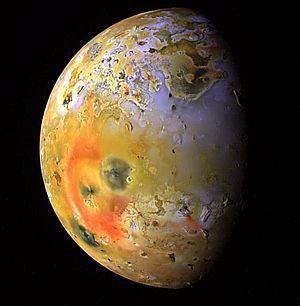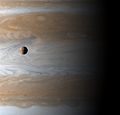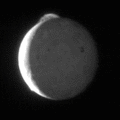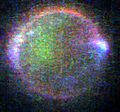Io (moon) facts for kids
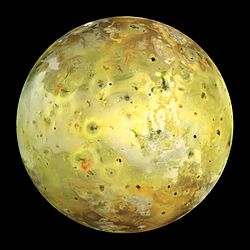
Galileo spacecraft true-color image of Io. The dark spot just left of the center is the erupting volcano Prometheus. The whitish plains on either side of it are coated with volcanically deposited sulfur dioxide frost. The yellower regions contain a higher proportion of sulfur
|
|||||||||
| Discovery | |||||||||
|---|---|---|---|---|---|---|---|---|---|
| Discovered by | Galileo Galilei | ||||||||
| Discovery date | January 7, 1610 | ||||||||
| Designations | |||||||||
| Jupiter I | |||||||||
| Adjectives | Ionian | ||||||||
| Orbital characteristics | |||||||||
| Periapsis | 420,000 km (0.002 807 AU) | ||||||||
| Apoapsis | 423,400 km (0.002 830 AU) | ||||||||
|
Mean orbit radius
|
421,700 km (0.002 819 AU) | ||||||||
| Eccentricity | 0.0041 | ||||||||
| 1.769 137 786 d (152 853.504 7 s, 42 h) | |||||||||
|
Average orbital speed
|
17.334 km/s | ||||||||
| Inclination | 2.21° (to the ecliptic) 0.05° (to Jupiter's equator) |
||||||||
| Satellite of | Jupiter | ||||||||
| Physical characteristics | |||||||||
| Dimensions | 3,660.0 × 3,637.4 × 3,630.6 km | ||||||||
|
Mean radius
|
1,821.3 km (0.286 Earths) | ||||||||
| 41,910,000 km2 (0.082 Earths) | |||||||||
| Volume | 2.53×1010 km3 (0.023 Earths) | ||||||||
| Mass | 8.9319×1022 kg (0.015 Earths) | ||||||||
|
Mean density
|
3.528 g/cm3 | ||||||||
| 1.796 m/s2 (0.183 g) | |||||||||
| 2.558 km/s | |||||||||
| synchronous | |||||||||
|
Equatorial rotation velocity
|
271 km/h | ||||||||
| Albedo | 0.63 ± 0.02 | ||||||||
|
|||||||||
| 5.02 (opposition) | |||||||||
| Atmosphere | |||||||||
|
Surface pressure
|
trace | ||||||||
| Composition by volume | 90% sulfur dioxide | ||||||||
Io (also called Jupiter I) is the closest of Jupiter's four largest moons. These four moons are known as the Galilean moons. Io is the fourth-largest moon in our Solar System.
It is also the densest moon and has the least amount of water of any known object in space. Io was discovered in 1610. It was named after a character from ancient Greek stories, Io, a priestess who became one of Zeus' partners.
Jupiter has many moons, between 80 and 95 in total. But only four of them are as big as Earth's Moon. Io is one of these four large moons. It is the third largest of the Galilean moons.
Io is about 3,642.6 kilometers (2,263 miles) wide. This is about 0.28 times the width of Earth. Its mass is only about 1.4% of Earth's mass.
It takes Io 42 hours to spin around once on its axis. It also takes 42 hours for Io to orbit Jupiter. This means the same side of Io always faces Jupiter. Our Moon does the same thing with Earth.
If you stood on Io, you would weigh much less than on Earth. Someone weighing 200 pounds (90 kg) on Earth would weigh about 36 pounds (16 kg) on Io. This is because Io's gravity pulls less on you.
Contents
Exploring Io: A Look at Its History

Io played a big part in how we learned about space in the 1600s and 1700s. Galileo Galilei discovered Io in January 1610. He also found the other three Galilean moons at the same time.
This discovery helped people understand that the Sun, not Earth, is the center of our Solar System. It also helped scientists like Johannes Kepler figure out how planets move. Later, it even helped with the first measurement of the speed of light.
For a long time, Io looked like just a tiny dot from Earth. By the late 1800s and early 1900s, telescopes improved. Scientists could then see large features on Io's surface, like its dark red poles and bright middle regions.
Spacecraft Missions to Io
In 1979, the two Voyager spacecraft flew past Io. They showed that Io is a very active world. It has many volcanoes and tall mountains. Its surface looks young, with no clear impact craters.
The Galileo spacecraft made several close visits to Io in the 1990s and early 2000s. It collected information about what Io is made of inside and what its surface is like. These missions also showed how Io affects Jupiter's strong magnetic field.
Other spacecraft have also observed Io. These include Cassini–Huygens in 2000 and New Horizons in 2007. Scientists have also studied Io using telescopes on Earth and the Hubble Space Telescope.
The first spacecraft to fly by Io were Pioneer 10 and 11. Pioneer 10 flew by on December 3, 1973, and Pioneer 11 on December 2, 1974. These missions helped scientists guess Io's mass more accurately.
They learned that Io is mostly made of rock, not water ice. The Pioneer missions also found a thin atmosphere around Io. They also detected strong radiation belts near Io's orbit.
Pioneer 11 took the only good picture of Io from these early missions. It showed Io's north polar region. Pioneer 10 was supposed to take close-up images, but the strong radiation prevented it.
Io's Unique Surface Features
Scientists expected to see many impact craters on Io. This was based on what they knew about the Moon, Mars, and Mercury. The number of craters usually tells us how old a planet's surface is.
But when Voyager 1 sent back its first images, scientists were surprised. Io's surface had almost no impact craters. Instead, it was covered in smooth plains. These plains had tall mountains, pits of different shapes, and lava flows.
Io's surface also showed many bright colors. These colors come from different sulfur compounds. Some people compared Io to a rotten orange or even a pizza.
The lack of craters meant Io's surface is very young. This is like Earth's surface. Volcanic materials constantly cover up any new craters. Voyager 1 confirmed this by seeing at least nine active volcanoes erupting.
Io's Active Geology
Io is the most geologically active object in our Solar System. It has over 400 active volcanoes. This extreme activity happens because of something called tidal heating.
Io is pulled by Jupiter's strong gravity and the gravity of other large moons. These moons are Europa, Ganymede, and Callisto. This pulling creates friction inside Io, which heats it up.
Some volcanoes on Io shoot plumes of sulfur and sulfur dioxide very high. These plumes can reach up to 500 kilometers (310 miles) above the surface. Io's surface also has more than 100 mountains. These mountains were pushed up by pressure in Io's rocky crust. Some of these peaks are even taller than Mount Everest.
Unlike most moons in the outer Solar System, Io is not made mostly of water ice. It is mainly made of silicate rock. This rock surrounds a core of molten iron or iron-sulfide. Most of Io's surface is covered by plains with sulfur and sulfur-dioxide frost.
Io's volcanoes create many of its unique features. The volcanic plumes and lava flows change the surface a lot. They paint the surface in shades of yellow, red, white, black, and green. These colors are mostly from different forms of sulfur. Sulfur changes color as it heats up and cools down.
Many long lava flows also mark the surface. Some are more than 500 kilometers (310 miles) long. The materials from these volcanoes form Io's thin, patchy atmosphere. They also contribute to Jupiter's huge magnetosphere.
Quick Facts About Io
- Io is the most volcanically active body in the Solar System.
- Io is one of the few moons that has an atmosphere, even if it is very thin.
- At any time, about 9 volcanoes are erupting on Io.
- Io is so close to Jupiter that Jupiter causes "tides" in its surface. These "tides" cause its intense volcanic activity.
- Io is one of only five of Jupiter's moons that can block the Sun as seen from Jupiter.
- Io is the fourth-largest moon in the solar system.
Images for kids
-
Size comparison between Io (lower left), the Moon (upper left) and Earth
-
Voyager 1 mosaic covering Io's south polar region. This includes two of Io's ten highest peaks, the Euboea Montes at upper extreme left and Haemus Mons at bottom.
-
The Cassini-Huygens mission's view of Io and Jupiter on January 1, 2001
-
Animation of the Laplace resonance of Io, Europa and Ganymede (conjunctions are highlighted by color changes)
-
Five-image sequence of New Horizons images showing Io's volcano Tvashtar spewing material 330 km above its surface
-
Galileo greyscale image of Tohil Mons, a 5.4-km-tall mountain
See also
 In Spanish: Ío (satélite) para niños
In Spanish: Ío (satélite) para niños


